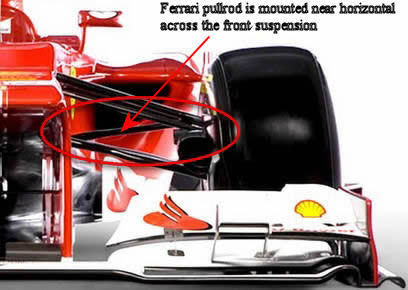
Audience
- Sentiment: Neutral
- Political Group: Generally apolitical audience
- Age Group: 20-40 years
- Gender: Male
Overview
- Exploration of pushrod vs. pullrod suspension systems in Formula 1 cars
- Discussion of the advantages and disadvantages of both suspension types
- Insight into the evolving technology and future of F1 suspension systems
The Science Behind Suspension: Pushrod vs. Pullrod in Formula 1
When you watch a Formula 1 (F1) race, you might find yourself awed by the speed, the skill of the drivers, and the insane precision of the cars. These machines aren’t just built for speed; they are a perfect blend of advanced technology, physics, and engineering. One vital aspect of the car’s design that many fans may overlook is the suspension system. It plays a significant role in how the car behaves on the track, influencing everything from aerodynamics to handling. Today, we’re diving deep into a fascinating aspect of F1 suspension systems—the choice between pushrod and pullrod layouts—and understanding why this decision is crucial for the performance of these incredible racing machines.
Suspension 101: What Is It?
Before we dive into the nitty-gritty of pushrod and pullrod systems, let’s understand what suspension is and why it matters. The suspension system in a car connects the vehicle to its wheels and helps absorb shocks from the road. Think about it like this: if you took a ride on the world’s bumpiest roller coaster, you would want to have something to cushion you from all those jolts, right? Well, the suspension does just that while playing a key role in keeping the tires in contact with the road (or track, in this case).
A good suspension system ensures that when a driver takes a turn at high speeds or hits a bump on the track, the car remains stable and grip is maintained. This stability is critical in a sport where fractions of a second can make all the difference in a race.
Pushrod Suspension: High on the Chassis
Now, let’s break down what pushrod suspension is. In this system, the rocker arm is mounted high on the chassis. The suspension components are attached to this rocker, and when the wheel moves up and down, the pushrod is pushed, resulting in the compression of the springs and shock absorbers. This layout is often seen in the rear of many F1 cars.
One major advantage of the pushrod system is its flexibility. It can easily be adjusted to suit different racing conditions and car setups. You get a solid connection between the wheel and the body of the car, which can help with handling in some situations. However, the higher placement of this setup can sometimes affect aerodynamics negatively.
Imagine trying to run while carrying a load over your head. It would make you less agile, wouldn’t it? The same principle applies here: having the suspension components high up can disturb airflow around the car.
Pullrod Suspension: Low to the Ground
Now let’s flip the coin and take a look at the pullrod suspension. In this configuration, the rocker arm is mounted lower on the chassis. As the name suggests, the pullrod is pulled down when the wheel moves, compressing the springs and dampers. This design is usually chosen for the front suspension of many modern F1 cars.
The main advantage of the pullrod system is that it generally offers better aerodynamic performance. Since components are located lower, there’s less obstruction to airflow, promoting a streamlined shape. Picture a bird soaring through the air—its body is sleek and designed to cut through the wind. The pullrod system has a similar effect on the car, creating less air resistance and potentially leading to better speed on the track.
Moreover, the lower position of the pullrod can help with weight distribution and improve the car’s center of gravity. This means the car can better handle corners and maintain stability, crucial for taking turns at breakneck speed.
A Visual Journey Through Suspension Systems
To truly appreciate the differences, let’s look at how some leading F1 teams have made their choices. Teams like Mercedes and Ferrari often employ pullrod systems in their front suspensions. This preference highlights how serious teams are about the benefits of aerodynamics and vehicle balance.
Contrastingly, some teams, while experimenting with pullrod setups, still use pushrods at the rear. This configuration might seem less optimal aerodynamically, but the pushrod setup can offer unique tuning options that some teams prefer. It raises an interesting question: Why do some teams stick with the pushrod layout despite its disadvantages? The answer usually comes down to what works best for their specific car design and driving style.
The Rising Rate Suspension
Let’s talk a little more about a fantastic innovation in suspension design: the rising rate suspension. This is a system where the spring rate—essentially how firm or soft the spring feels—changes as the wheel travels upward and downward.
In a pullrod setup, the rate might increase as the wheel moves up, which can provide more support for the car when it hits big bumps or uneven pavement. This characteristic can dramatically improve ride comfort and handling. In simpler terms, it allows the car to absorb big hits while remaining stable at high speeds—something super important during intense races.
Which Configuration Wins the Race?
When it all boils down to a race, both the pushrod and pullrod configurations have their pros and cons. They can both achieve impressive performance under the right conditions, and teams spend countless hours on simulations and tests to ensure they find the best balance for their cars.
However, as racing has progressed into modern high-speed circuits, there’s a growing tendency to lean towards pullrod systems, especially in the front suspension. This shift reflects the increasing importance of aerodynamics, especially in a sport where every tiny detail counts dramatically in achieving lower lap times.
In today’s F1, the pullrod system—thanks to its aerodynamic advantages and superior stability—is often seen as the better choice. It allows engineers and drivers to optimize the car’s performance in various conditions, striking a balance between speed and control.
The Future of Suspension in F1
As technology continues to evolve, we can only imagine what the future holds for F1 suspension systems. Engineers are constantly pushing the boundaries, exploring new materials, designs, and setups that can enhance vehicle performance. Additionally, given the nature of F1 where innovation is crucial, we might soon see even more sophisticated systems that further integrate with the overall vehicle design.
With the sport continually evolving, and new teams entering the competition, the debate between pushrod and pullrod will likely remain relevant for years to come. And who knows? Perhaps a completely new suspension setup will rise to prominence, changing the dynamics of racing once more.
Final Thoughts
The choice between pushrod and pullrod systems in Formula 1 cars is a fascinating topic that highlights how nuanced the engineering behind these machines truly is. It’s a high-stakes decision that impacts everything from the car’s aerodynamics to its stability and handling—every single part plays an essential role in the grander scheme of racing.
So, what do you think? Do you lean towards the aerodynamic benefits of the pullrod system, or do you prefer the flexibility and tradition of pushrod designs? Whether you’re cheering for your favorite driver or simply curious about the complexities behind racing technology, there’s so much more to discover in the world of Formula 1. Share your thoughts and comments below—I’d love to hear your take on this mechanical showdown!




